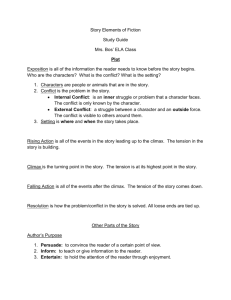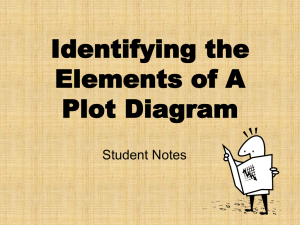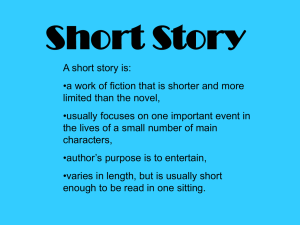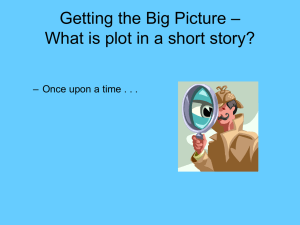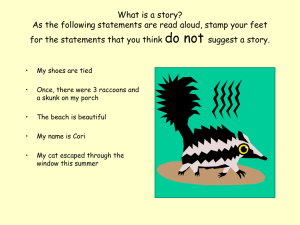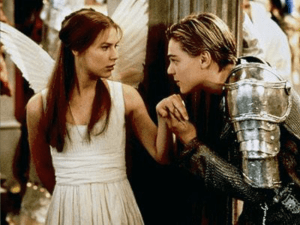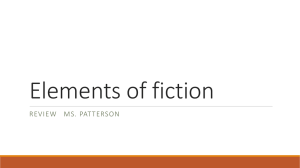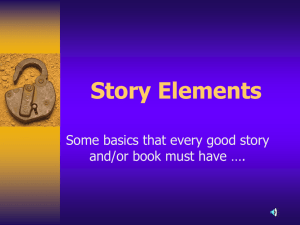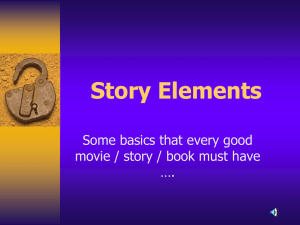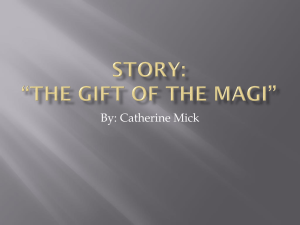Short Story Elements
advertisement
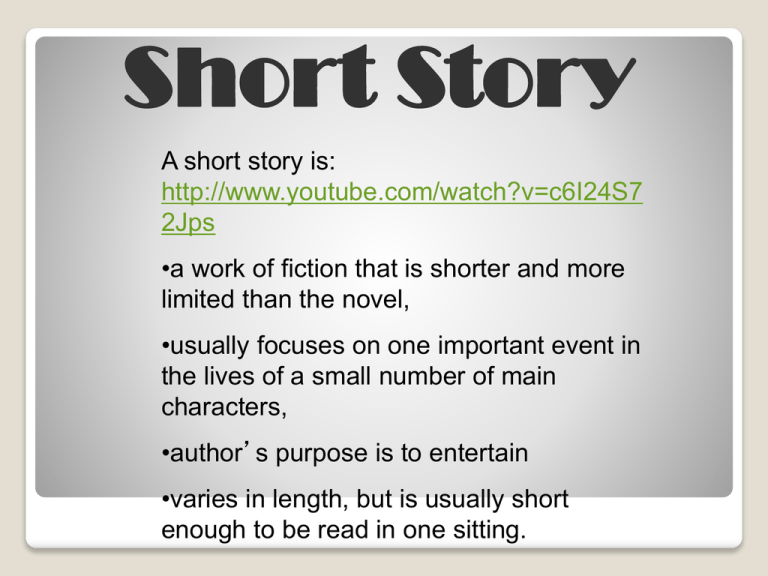
Short Story A short story is: http://www.youtube.com/watch?v=c6I24S7 2Jps •a work of fiction that is shorter and more limited than the novel, •usually focuses on one important event in the lives of a small number of main characters, •author’s purpose is to entertain •varies in length, but is usually short enough to be read in one sitting. Plot Development Plot Diagram Climax exposition Plot: The sequence of events in a story. resolution Exposition Climax exposition resolution Exposition: the author introduces the characters, creates the setting, and introduces the conflict. ExpositionSetting: Setting: Includes where and when the story takes place. How setting is expressed: 1. 2. 3. 4. 5. 6. 7. Place Time of day Weather Seasons Type of People Kinds of clothing Smells, sounds Exposition Character: Character: Person, animal, or imaginary creature that plays a role in the story. Types of Characters: Protagonist: main character in the story, hero(ine). Antagonist: character that causes the initial conflict . . . The bad guy/girl Round: character with many personalities. He/she has many strengths and weaknesses. Flat: this character usually has one kind of personality, such as only good or only evil. Often, less important in the story. Dynamic: this character changes because of what happens to him or her in the story. Often this character learns as a result of an event in the story. Static: This character stays the same throughout the story. Conflict: Conflict: A struggle or clash between two opposing forces. Conflict: Internal Conflict: External Conflict: Struggle occurs within the character Struggle occurs between the character and an outside force. Person vs. Self Person vs. Person Person vs. Society Person vs. Nature, Person vs. Unknown, Person vs. Technology, Person vs. Supernatural Rising Action & Climax As they say in writing and reading circles . . . the plot thickens!!! Plot Diagram: Rising Action Climax exposition resolution Rising Action: a series of crises, events or turning points that build tension towards the climax. Plot Diagram: Climax exposition Climax resolution Climax: The most intense or crucial moment or event when the tension reaches a peak. Rising Action: The stairs leading up to the top. There are many stairs that lead there. Climax: You have reached the top of the stairs after a long climb. This is the highest point with the most excitement. It is the turning point that resolves the conflict or problem Falling Action & Resolution Plot Diagram: Falling Action Climax exposition resolution Falling Action: The story examines the consequences or outcomes of the climax and the tension fades. Falling Action: After reaching the climax, the stairs lead back down. There may be many stairs or just a few that lead there. Resolution: The problem or conflict is solved. The last puzzle piece is put into place. Plot Diagram: Resolution Climax exposition resolution Resolution: The story’s main problem or conflict is resolved, bringing the conflict to an end. Theme Theme is the underlying meaning of the story, a universal truth, a significant statement the story is making about society, human nature, or the human condition. Theme is written as a statement. Video on Theme Possible Theme Topics: Principles of Distinction COOPERATION INTEGRITY FAIRNESS COURAGE COMMITMENT TRUST EMPATHY COMMUNICATION FRIENDSHIP TOLERANCE RESPECT HUMOR RESPONSIBILITY ENTHUSIASM Point of View Perspective from which the story is told. 1st person: In the first person point of view, the narrator is a character in the story. He/She will use pronouns like “I” “we” “. When reading stories in the first person, we need to realize that what the narrator is recounting might not be the objective truth. We should question the trustworthiness of the accounting. 3rd Person : Here the narrator does not participate in the action of the story as one of the characters, but lets us know exactly how the characters feel. We learn about the characters through this outside voice. Types of 3rd person Point of View Omniscient Points of View (3rd person) A narrator who knows everything about all the characters is all knowing or omniscient. Limited Points of View (3rd person) A narrator whose knowledge is limited to one character, either major or minor, has a limited omniscient point of view. As you read a piece of fiction think about these things: •How does the point of view affect your responses to the characters? •How is your response influenced by how much the narrator knows and how objective he or she is? •First person narrators are not always trustworthy. •It is up to you, the reader, to determine what is the truth and what is not. Suspense is the quality that is created when the reader is uncertain about what will happen next. Foreshadowing is the use of hints or clues in a narrative to suggest what action is to come. Flashback occurs when the author interrupts the action of the story to give us information that occurred before the story began. Tone is the emotion exposed as the writer selects words and phrases to amuse, anger, or shock the reader. Mood is the feeling that the reader has as he or she is interacting with the text. Plot Development Techniques Comparisons ◦ Analogy- a similarity between like features of two things ◦ Simile- uses like or as to compare 2 things ◦ Metaphor- does not use like or as to compare ◦ Allusion- comparison to a famous person or situation Exaggeration ◦ Hyperbole- highly exaggerated statement ◦ Idiom- an expression whose meaning is not the literal meaning but a figurative one Sounds ◦ Onomatopoeia- the word is the sound ◦ Alliteration- repeating beginning sounds for effect Other ◦ Personification- giving human qualities to inanimate objects ◦ Symbolism- giving special meaning to an object or person Will Farrell video Figurative Language Shirley Jackson, 1916-1965, one of the most brilliant and influential authors of the twentieth century, is widely acclaimed for her stories and novels of the supernatural, including the wellknown short story “The Lottery” and the best-selling novel “The Haunting of Hill House.” Shirley Jackson wrote in two styles. She could describe the delights and turmoil's of ordinary domestic life with detached hilarity; and she could, with cryptic symbolism, write a tenebrous horror story in the Gothic mold in which abnormal behavior seemed perilously ordinary. Excerpt from her obituary published in the New York Times on August 10, 1965 (December, 14, 1916 - August, 9 1965) “The Lottery” by Shirley Jackson Boisterous: noisy and lively; unrestrained or unruly Reprimand: harsh criticism from an authority figure. Interminably: endless or seemingly endless because of monotony or tiresome length Petulantly: easily annoyed, complaining rudely, impatient irritation Vocabulary Dialogue is the conversation between two or more characters in a novel, short story, drama, etc. Dialogue is set aside by the use of quotation marks and a short explanation of who spoke the words. There can also be a descriptive word used to describe how the words were spoken. Every time a speaker changes, a new paragraph should begin. Dialogue * * Rising Action- how does the author increase our tension throughout the story? * Point-of-View- why does the author choose to tell the story in third person? * Foreshadowing- how does the author foreshadow the outcome of the story? * Symbolism- how were the symbols of the rocks and the color black used in the story? “Tell-Tale Heart” By Edgar Allan Poe Poe was born in Boston. He was a poet, writer, editor, and literary critic. His short stories were his main type of writing, and today they are considered some of the best American short stories in history. His tales usually are a mix of mystery and macabre (grim and dealing with death). Poe married his 13-year old cousin, Virginia Clemm. Her early death may have inspired some of his writing. Poe’s best known fiction are Gothic (horror and romance ) in order to appeal to the public’s tastes at the time. born January 19, 1809, Boston, Mass died October 7, 1849, Baltimore, Maryland Biography Vocabulary Resembled – looked like Distinctly – clearly Cunning – slyly, carefully, cautiously Hideous – very ugly or frightful “I think it was his eye. Yes, it was his eye! One of his eyes was pale blue and dull. It resembled the eye of a vulture.” Story Elements to focus on… Rising Action- how does the author increase our tension throughout the story? Point-of-View- why does the author choose to tell the story in third person? Foreshadowing- how does the author foreshadow the outcome of the story? Symbolism- how were the symbols of the rocks and the color black used in the story? “The Tell-Tale Heart” is a fun little horror story where the narrator is driven almost insane because of his obsession with an old man’s creepy eye! The narrator thinks he’s perfectly sane and tries to convince the reader throughout the story. He is suffering from extreme paranoia and mental health issues. Ask yourself: What point of view is the story in? Ask yourself: Whose heart does he really hear beating? Direct vs. Indirect Characterization Direct Characterization: the writer makes direct statements about a character's personality: tells what the character is like. Direct Characterization: Ed Johnson scratched his head in confusion as the sales rep explained Dralco’s newest engine performance diagnostic computer. The old mechanic hated modern electronics, preferring the old days when all he needed was a stack of manuals and a good set of tools. Ervin II, Terry . "Fiction Factor - Direct vs. Indirect Characterization." Fiction Factor - Writing Tips for Fiction Writers. N.p., n.d. Web. 6 Oct. 2010. <http://www.fictionfactor.com/guests Indirect Characterization: the writer reveals information about a character and his personality through that character's: thoughts, words, and actions, how other characters respond to that character, including what they think and say about him. Indirect Characterization: “That Ed Johnson,” said Anderson, watching the old mechanic scratch his head in confusion as the sales rep explained Dralco’s newest engine performance diagnostic computer. “He hasn’t got a clue about modern electronics. Give him a good set of tools and a stack of yellowing manuals with a carburetor needing repair, and he’d be happy as a hungry frog in a fly-field.” Motive is the reason a character takes a specific course of action. ◦ Not all motives are bad. ◦ Some motives can help lead the character to a resolution. Motive “Harrison Bergeron” by Kurt Vonnegut Writer, novelist. Born on November 11, 1922, in Indianapolis, Indiana. Kurt Vonnegut is considered one of the most influential American novelists of the twentieth century. He blended literature with science fiction and humor, the absurd with pointed social commentary. Vonnegut created his own unique world in each of his novels and filled them with unusual characters, such as the alien race known as the Tralfamadorians in Slaughterhouse-Five (1969). Other novels/stories: The Sirens of Titan (1959), Mother Night (1961), Cat's Cradle (1963), Breakfast of Champions (1973), Jailbird (1979), Deadeye Dick (1982), Palm Sunday: An Autobiographical Collage (1981), and Timequake (1997). November 11, 1922-April 11, 2007 Biography Vocabulary Vigilance: watchful especially to avoid danger Luminous: bathed in or exposed to steady light Doozy: something that is unusually good, bad, big, severe, etc. Story elements to focus on… Climax- why does the author spend so much time on the climax? Motive/Conflict- what is it about the main conflict that causes Harrison to behave the way he does? Theme/Symbolism- how does the symbol of the handicaps help the reader understand theme? Tone- how does the author’s choice of words cause the reader to feel shocked? One of Russia's greatest writers, Chekhov began his career writing jokes and anecdotes for popular magazines to support himself while he studied to become a doctor. Between 1888 and his death he single-handedly revolutionized both the drama and the short story. Near the end of his life he married an actress, Olga Knipper. He died from tuberculosis in 1904, age 44. Biography taken from: http://chekhov2.tripod.com/ “The Bet by Anton Chekhov * Rubles: the basic unit of money of Russia * Stake: something that you could win or lose in a game, contest, etc. * Haphazardly: having no plan, order, or direction * Contempt: a feeling that someone or something is not worthy of any respect or approval * Emitted * Lackadaisical * Stealthy * prominent Vocabulary Story elements to focus on… Falling action- how does the author wrap up our questions about the lawyer’s action? Does the author’s explanations satisfy you? Motive/conflict- What was the conflict in the beginning and what was the lawyer’s motive for leaving early? Suspense- what is the question the reader has throughout the story? How is finally answered? Factual Questions have only ONE correct answer. Factual questions address only ONE specific part of the story. Interpretive Questions have MORE THAN ONE possible answer Interpretive Questions apply to MORE THAN ONE part of the story. Factual vs. Interpretive Questions Practice Does the lawyer stay for the entire 15 years? Why did the lawyer leave 5 minutes early? Ray Bradbury is one of those rare individuals whose writing has changed the way people think. His more than five hundred published works -- short stories, novels, plays, screenplays, television scripts, and verse -- exemplify the American imagination at its most creative. Once read, his words are never forgotten. His best-known and most beloved books, THE MARTIAN CHRONICLES, THE ILLUSTRATED MAN, FAHRENHEIT 451 and SOMETHING WICKED THIS WAY COMES, are masterworks that readers carry with them over a lifetime. August 22, 1920- June 5, 2012 “All Summer in a Day”video by Ray Bradbury Slackened- to become less active Surged- a strong wavelike forward movement Tumultuously- highly agitated Vocabulary Watch video: All Summer in a Day Story elements to focus on… Resolution- why do you think the author ends the story so quickly? Motive/Conflict- why do you think the other characters react to Margot in a negative way? How does that reaction contribute to Margot’s main conflict? Tone- how does the author use word choice to make the reader feel stunned in the end? Suspense is the quality that is created when the reader is uncertain about what will happen next. In “The Bet” readers are left wondering if the man will stay the whole time or if the banker will win the bet. In “The Tell-Tale Heart” readers are left wondering if the man will confess his crime. Suspense Foreshadowing is the use of hints or clues in a narrative to suggest what action is to come. Foreshadowing Flashback occurs when the author interrupts the action of the story to give us information that occurred before the story began. At the beginning of “The Tell-Tale Heart” and “The Bet”, both authors tell us that the story they are about to tell has already occurred. Flashback Will Ferrell on Figurative Language Figurative Language Dramatic Irony occurs when the reader knows something that a character does not. For example in the story “Charles”, we know that the boy Laurie is actually the child Charles long before the mother does. Dramatic Irony The attitude a writer takes toward his or her subject, characters, and readers. Through tone, a writer can amuse, anger, or shock the reader. Tone is created through the choice of words and details. Tone Mood
